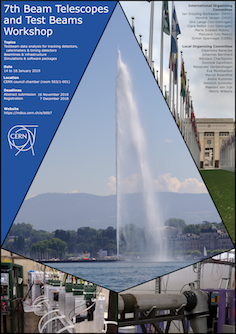Speaker
Description
A hyper-precise time reference is needed for characterization measurements of precise timing detector prototypes. The reference detector is normally placed together with a device under test (DUT) in a beam telescope. The time resolution of this reference detector should be considerably better than the time resolution of the DUT. Measurements with MCP-PMTs of the type R3809U-50 by Hamamatsu have been performed in order to characterize their spatial distribution of the time resolution and to validate them as a proper t0-reference detector. These measurements were conducted during the tests of precise-timing Picosec Micromegas prototypes at the CERN/SPS-H4 beam line using a beam telescope consisting of three triple-GEM tracker and various trigger detectors. A time resolution of up to 3.75±0.14 ps has been obtained in the inner part of the active area of the MCP-PMT.
The time resolution declines up to several ten picoseconds in the outer parts due to decreasing pulse amplitudes. The Cherenkov light cone is not anymore fully projected onto the photocathode in this region. Less and less photoelectrons are extracted from the photocathode by the diminishing light. The measurement shows a coherence to the theoretical expected relation between the time resolution and the initial number of photoelectrons.
This contribution will present the general beam setup of the Picosec Micromegas collaboration as well as the detailed studies of the MCP-PMT as a t0 reference detector.




